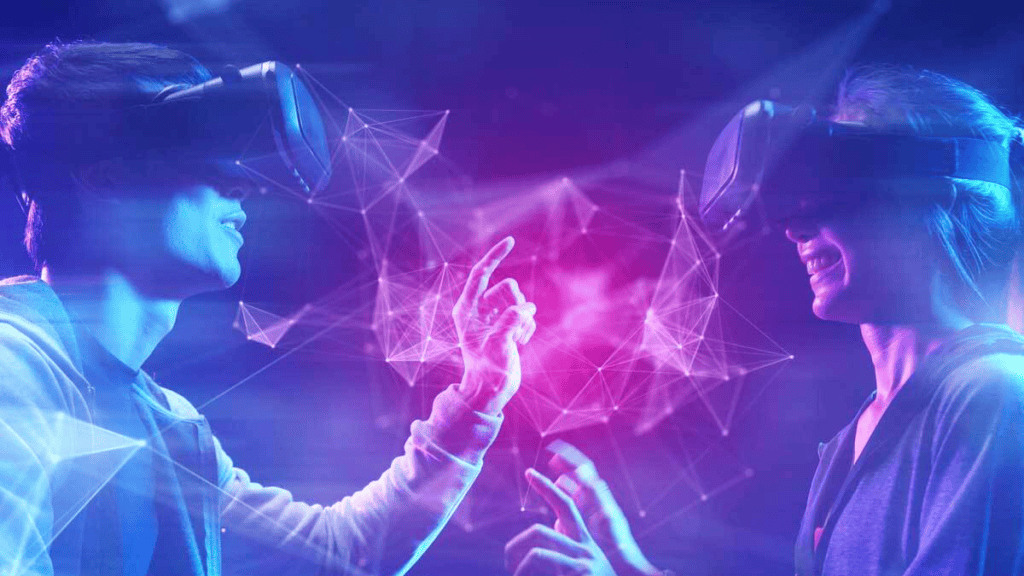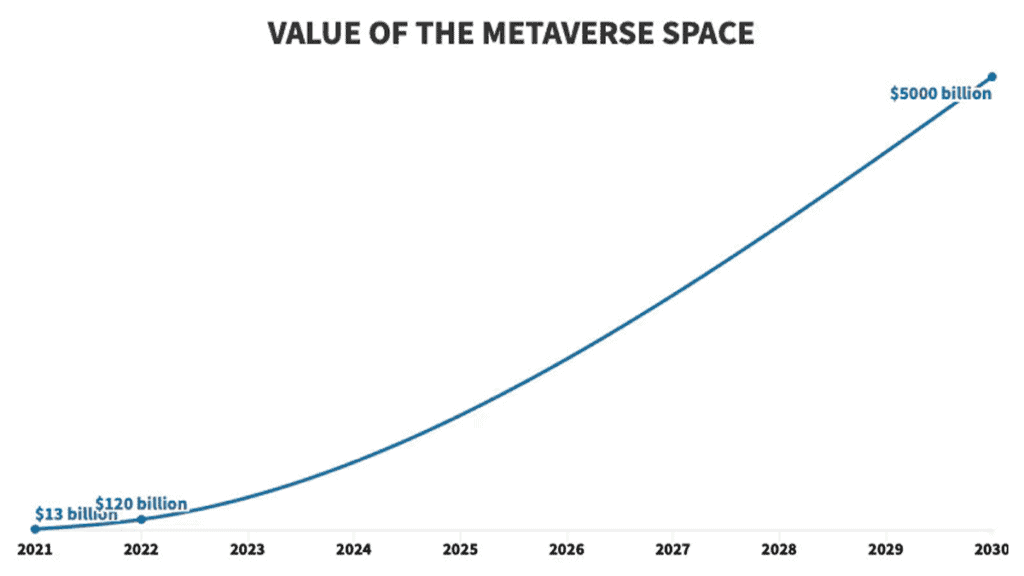The Evolving Landscape of the $5 Trillion Metaverse

The metaverse is anticipated to become a $5 trillion market by 2030, driven by mainstream tech corporations’ efforts to popularize it in a Web2 fashion and technological developments such as high-speed internet and cell phones becoming tiny supercomputers.
Since the beginning of 2021, it has brought Web3 and cryptocurrency to the general public. While experiencing the same connected virtual world predates the Web3 era, the blockchain-enabled players become governors and stakeholders in the virtual universe they inhabit.
Despite its vast potential, it lacks an interconnected landscape that allows users to have a pleasant experience. Over 160 companies are developing metaverses across several blockchains and layers, and the absence of network compatibility results in a highly fragmented landscape.
Beyond Entertainment: Exploring the $5 Trillion Metaverse
The metaverse and the services development corporation provides can transform media and entertainment significantly in the years ahead. The combination of virtual reality, blockchain, and artificial intelligence with the $5 trillion metaverse technologies will allow for new types of immersive storytelling, interactive gaming, virtual live events, and enhanced marketing methods in virtual space.
The following offers a glimpse into how it is poised to reshape different industries:
| Industry | Description |
| Shop in 3D | Virtual markets allow users to buy and trade virtual things using cryptocurrencies. Businesses can present their items interactively in 3D shops. |
| Virtual Socialization | Attend virtual events such as concerts or conferences worldwide and interact with others in the real-time metaverse. They built communities based on shared interests. |
| Learn Immersive | Experience teaching and learning using virtual classrooms and simulations. |
| Healthcare Evolves | Access health-related knowledge through virtual consultation sessions. |
| Travel Remotely | Discover virtual destinations without leaving your house. Take guided tours of historical places and landmarks. |
| Virtual Real Estates | Buy, sell, and create virtual properties in the metaverse. |
New opportunities and challenges will develop as these technologies advance and modify our interactions with different industries.
Building Blocks of the $5 Trillion Metaverse
The metaverse, a virtual universe set to transform various parts of our lives, is built based on essential building pieces. Combined, this could establish a transformational and scalable virtual ecology.
Immersive Technologies Take Center Stage
Virtual and augmented reality technologies play an essential role. Virtual reality is used to create an entirely digital environment. Meanwhile, augmented reality refers to digital elements in the physical world. Together, they produce experiences that blur the distinction between the physical and digital worlds.
Crafting the Metaverse Landscape
Development of virtual worlds and environments, including realistic 3D models, buildings, and landscapes. The digital content serves as the foundation for the metaverse.
Open and Interconnected platforms
The metaverse uses blockchain technology to provide an open and decentralized platform. This enables users to transition between virtual places effortlessly, making teamwork more cohesive throughout.
A user-centric approach is paramount
Successful metaverses prioritize user-centric design principles. It is critical to transition between physical and digital reality seamlessly. Users feel an intense sensation of presence, which fosters a sense of connectedness.
Investing in the Future: The Metaverse

A rising virtual world where the physical and digital converge is predicted to be a $5 trillion economy by 2030. This quick rise demonstrates how a wealth of exciting investments might provide chances for anyone seeking a career in Technology. Here are the several ways for investors to unleash their potential:
| Investment Category | Description | Illustration |
| Metaverse Platform & cryptocurrencies | Invest Tokens are utilized in the virtual world to acquire exposure to their growth. | Decentraland (MANA) and Sandbox (SAND) |
| Non-Fungible Tokens (NFTs) | Investing in corporate buildings incorporating metaverse infrastructure, technologies, and virtual commerce. | Virtual artworks, metaverse Land plots, and digital clothing. |
| Metaverse Real estate | Purchasing digital land parcels on established networks may be valuable. Decentraland (MANA) and Sandbox (SAND). | Decentraland (MANA) and Sandbox (SAND) |
| Metaverse-Focused Stocks & ETFs | Investing in corporate buildings incorporating metaverse infrastructure, technologies, and virtual commerce. | Roundhill Metaverse ETF (METV) |
| Emerging Technology | Emerging Technology Investing in important technology businesses that enable the metaverse, such as VR, AR, blockchain, and Big Data. | VR/AR like Meta (Formerly Facebook), Blockchain like ConsenSys and Big Data like Amazon Web Services (AWS) |
Business Transformation in the Metaverse
The metaverse is a fascinating idea that has gained popularity in recent years. It is a 3D virtual world that improves the online experience and allows users to interact realistically. The metaverse has far-reaching business effects. It intends to transform communication between people and businesses, opening up fresh possibilities for involvement.
According to Hyperspace, the business implications are:
| Implication | Description |
| Enhanced Communication | The metaverse facilitates realistic and interactive reach between companies and customers, breaking down geographical limitations. Consider virtual meetings or conferences where participants feel they are in the same room, regardless of place. |
| Immersive Experiences | Businesses may provide customers with engaging experiences by allowing them to explore virtual surroundings and engage with products in new ways. Consider a virtual showroom where buyers may drive cars or try on clothes in a realistic environment. |
| Collaborative Tasks | The metaverse allows teams to collaborate and connect easily, even if huge distances separate them. Virtual workspaces can be developed to enable teams to share ideas, and collaborate in real-time. |
| Global Impact | The metaverse eliminates geographical barriers, allowing businesses to access clients anywhere. This results in a substantially more extensive potential consumer base and a broader market reach. |
| Personalized Interactions | Businesses can use avatars in the metaverse to personalize and tailor customer interactions. Consider a virtual shopping assistant that can answer inquiries, suggest products based on personal interests, and increase consumer pleasure and loyalty (Hyperscape, n.d.). |
The metaverse can transform multiple industries and unlocking the amazement of $5 trillion by 2030 which can be an economic opportunities. To navigate the digital revolution, companies must embrace and adapt to a constantly shifting landscape. This new frontier provides virtual real estate development, marketing, virtual entertainment, and consultation services, among other new business concepts.
Maya Chen’s journey began in software development, focusing on virtual reality simulations. With a degree in computer science and a knack for creating immersive experiences, Maya saw the potential of VR and AR to transform entertainment and education.

